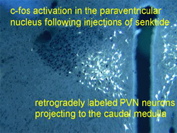Neural Mechanisms of Osmoregulation
Graduate Neuroscience Program - Flynn Lab
Research:
My research focuses on identifying the neural and hormonal systems that are involved in the control fluid balance. The regulation of fluid balance requires behavioral (control of salt intake) and neuroendocrine responses (release of vasopressin and oxytocin), and our laboratory focuses on the neural mechanisms that underlie these responses. Behavioral testing, neuroanatomical tracing, immunohistochemical, and molecular biology techniques are used to identify the neural structures and chemical phenotypes of neurons that participate in the regulation of fluid balance and osmoregulation.
Techniques, like those shown in the photomicrograph, are currently used in the lab to characterize neural systems regulating salt intake. Immunohistochemistry revealed that following an osmotic challenge, the tachykinin NK3 receptor that is expressed on vasopressin neurons is activated, internalized to the cytoplasm and then transported to the cell nucleus! This receptor contains the peptide sequence needed for transport to the nucleus where it may act as a transcription factor, to perhaps regulate the expression of vasopressin or other receptors. We have purified the nucleus and verified by Western analysis that the receptor is present in the nucleus following osmotic challenge. Just what a membrane (g-protein coupled) receptor is doing in the cell nucleus is a rather interesting question.

